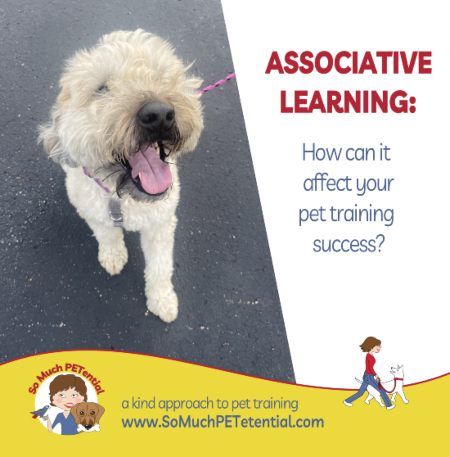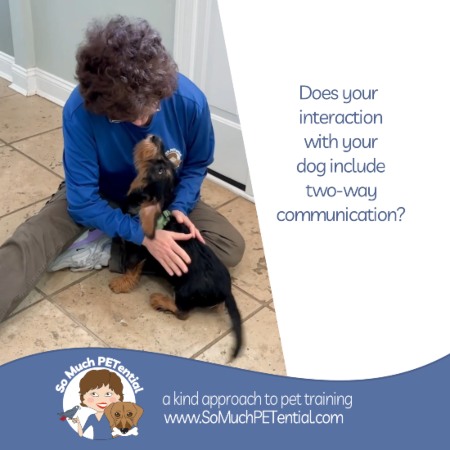
Associative learning refers to our learning associations with people, things, the environment based upon what happened in and around them in the past. We learn to increase the frequency of a behavior or strengthen it if that causes valued outcomes. We also have a reflexive kind of learning. Our heartrate may increase if there is an expectation that something unpleasant or overly exciting happened the last time we were in that situation.
Understanding and remembering this is valuable when it comes to developing positive approaches to solving behavior issues. Remember, behavior does not occur in a vacuum. Past consequences are predictors of future behaviors.
Here are a few real-life examples of associative learning.
Dogs and puppies may back up from people who reach over their head, bend over them, or give them a bear hug. With repeated occurrences (even with just one experience), there is a likelihood he will come to or interact with those people less frequently because he predicts coming near those people means having unpleasant things happen. Staying away avoids any chance of that outcome. The dog may also begin to pace, have an accelerated heart rate, tense his muscles, or tuck his tail in the presence of the person who has done those things to him (classical conditioning).
If a dog had an unpleasant visit to a groomer, that dog could begin showing those reflexive responses (accelerated heart rate, tense muscles, etc.) when arriving at the groomer. As associations are generalized, he could begin showing those responses in the parking lot of the groomer, in the car, or even at home when approaching the garage in anticipation of those things leading up to having to go into the groomer.
If experience has taught a parrot that hands coming near him typically result in the hand forcing that parrot to do something unpleasant, he may begin showing behaviors to try and get distance…such as body stiffening, dilating eyes, leaning or moving away…or biting.
Pet Behavior Problem Solving
With any of these situations, paying attention to the environment surrounding and impacting your pet’s specific behaviors is an important piece of coming up with a positive and least intrusive actionable behavior modification plan. What happened before the behaviors, and what happened after the behaviors? (In Applied Behavior Analysis terms, what are the antecedents and what are the consequences of the behaviors?)
There are many ways to approach a plan. They involve looking at the function a specific behavior serves the animal (such as, whether the behavior is helping that animal move toward something positive or away from something negative), and management/structure to prevent practice of the problem behavior while teaching new associations and behaviors.
Some psychology terms with which to become familiar:
Agency refers to one’s ability to have control over his/her environment, decisions, and life. Please Associative learning. What is it and how can understanding it help you to have a ‘better behaved’ pet? How does associative learning impact your success in dog training, parrot training or other pet training? Please click here learn more about agency and its role in dog training from my blog post.
Counter conditioning refers to an animal’s conditioned emotional response to a stimulus being replaced with an opposite response. This will only occur if the new stimulus causes a response powerful enough to replace the problem response. Here is an example of my supporting a dog that is afraid (shown through these dog stress signals – barking, lunging, backing up, tail tucked, lowered body posture) of unfamiliar men across the street. I can set up the environment so that the dog can see a man at a distance where my learner can continue to have loose muscles. When the dog sees the person, I can follow that sighting with something he highly enjoys like a treat scatter or personal play. My learner will have complete agency to choose to communicate stress and move away if needed. It is important for me to notice even his most subtle body language and give him distance when desired.
As the dog shows through his body language that he can remain relaxed and able to engage in my personal play or treat scatters, we can close the distance in small increments. THIS is referred to as systematic desensitization. It is the process of extinguishing a conditioned emotional trigger response gradually by exposing the animal at a low enough ‘dose’ of the trigger so that the learner can be relaxed, and only presenting the next level of exposure when the learner still shows no fear response.
Changing Your Pet’s Associative Learning
Let’s look at the examples above. Behavior is ALWAYS the study of ONE so please keep in mind, these are only general ideas. Watching and taking feedback from the dog in front of you is very important as each dog will have different needs, learning history, and other contributing factors.
For the dog that backs away from people who have a history of putting their hands and body in places that make him uncomfortable, those people can teach their dog new, more positive associations with moving toward people. Part of that plan should be to stop doing what their pet has indicated is unpleasant. The dog should have complete agency to move in any direction that helps him feel safe. In the beginning, people can reinforce any movement toward them by tossing a treat in the other direction or by placing treats on the ground and moving away. Or, if their dog loves to chase, they could move quickly in the opposite direction of their dog and give their dog treats for catching them.
Please click here to see my post and video on my greeting a sensitive dog.
Please click here to see my post on practicing Consent to Pet.
If your dog had a negative association with the groomer, try to find out what happened and what triggered the stress and see if your groomer can work with your dog and you to come up with a low stress handling plan. You can practice cooperative care training at home. You can schedule ‘happy visits’ to the groomer. You may want to talk to your veterinarian about possible anti-anxiety medication for those occasions. You may also need to desensitize your dog to each step that was triggering a fear response in your dog.
With the parrot, it is important to learn how your pet communicates a NO response or stress so that you can respond by giving your bird space. Teaching your bird to come to and step up onto you rather than you pushing your hand into his space and forcing the issue of stepping up is a much more empowering, positive and humane way to build your relationship.
These are just a few scenarios and a few ideas for solving pet behavior problems in positive ways. There are lots of ways to be creative with this process. The beauty of looking at behavior this way is that you are not only solving issues, you are enriching your pet’s life, and strengthening your relationship with it at the same time. Everyone wins!






